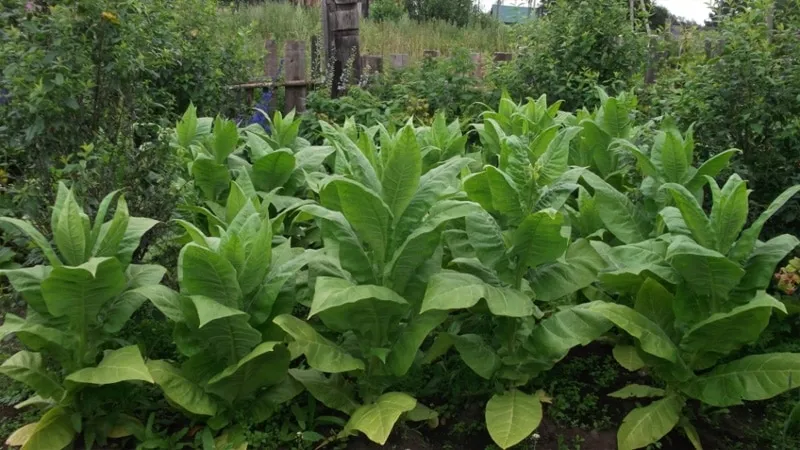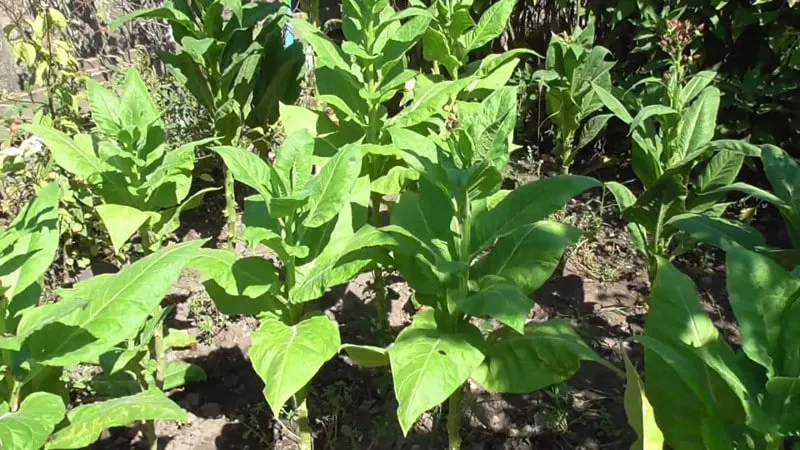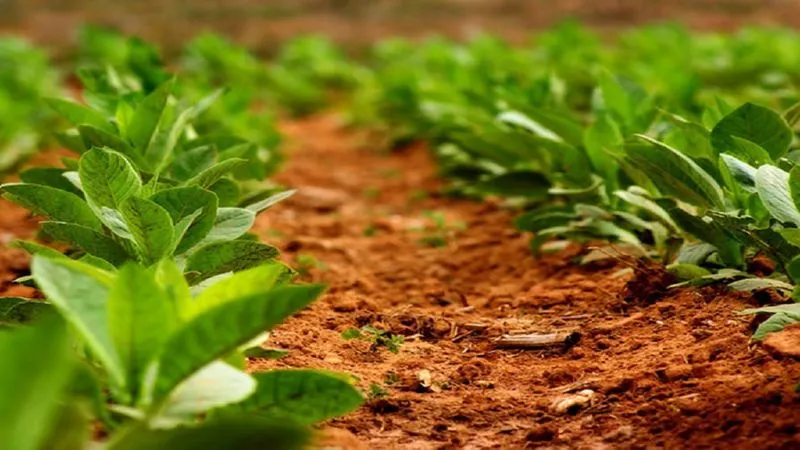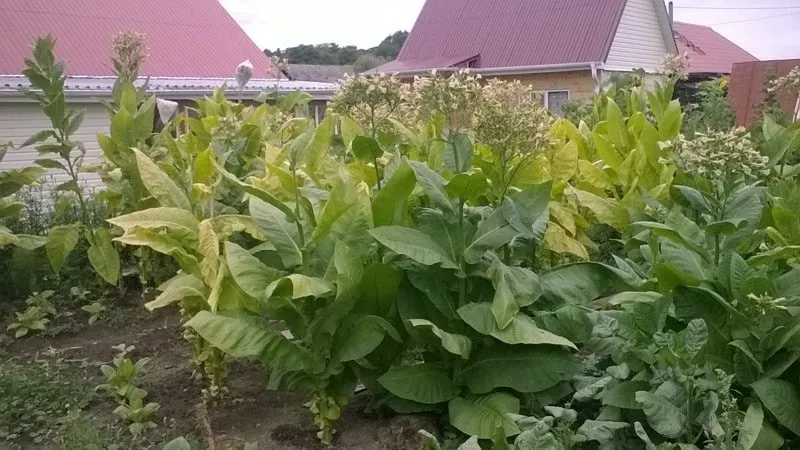Tobacco is a plant that thrives in warm and humid conditions. The preferred regions for its cultivation are southern areas with a hot climate. In temperate zones, this plant is grown in greenhouses. Growing tobacco from seeds is no more difficult than growing tomatoes. In this article, we will explain how to plant tobacco, combat pests and diseases, and process the leaves for storage and use.
Table of contents
Is It Worth Growing Your Own Tobacco?

Many gardeners ask themselves this question. On one hand, homegrown tobacco is undoubtedly of higher quality than store-bought products. On the other hand, a standard 600 m² garden plot may not be enough to supply a year’s worth of tobacco—other crops also need space.
If you simply want to experiment, a small bed in a greenhouse or outdoors will suffice. For large-scale cultivation, a significant area is required.
Important! Before sowing tobacco, familiarize yourself with its varieties and their characteristics. In Europe, cigarette tobacco of two main types is commonly grown, while in the Americas, cigar tobacco is more prevalent.
Advantages and Disadvantages of Homegrown Tobacco
A major advantage of growing your own tobacco is its purity. Commercial cigarettes contain not only tobacco but also resins, various additives, and flavorings that further harm the smoker’s health.
Another benefit is cost savings. The average price of a pack of cigarettes is €5–€10. Switching to homegrown tobacco can save a household at least €500–€1000 per year.
Parts of the tobacco plant not used for smoking can also serve as a natural pest repellent for garden plants. The downside of cultivation is that predicting varietal characteristics is nearly impossible.
The final result depends on many factors:
- soil composition;
- weather conditions;
- fertilization;
- plant care.
When selecting a tobacco variety for home cultivation, consider not only its yield but also its adaptability to different climatic conditions.
How to Grow Tobacco

In most European regions, tobacco is cultivated using seedlings. Since the plant has a long growing season, seeds are sown as early as February or early March. This crop requires long daylight hours, so transplanting into the ground is best done in late May or early June.
Tobacco grows well in almost any soil, but the quality of the final product depends on the nitrogen, phosphorus, and potassium content in the soil.
Important! Do not grow tobacco in the same location consecutively. Wait at least four years before replanting it in the same spot. After tobacco cultivation, the soil requires heavy fertilization, as the plant depletes minerals during its intensive growth phase.
Seed Preparation and Germination
Two to three days before sowing, treat the seeds with a weak potassium permanganate solution, rinse, and dry them. Since tobacco seeds are very small, the best germination method is placing them on moist, layered toilet paper.
Once the seeds sprout and develop roots, carefully transfer the seedlings to peat pots or seedling trays using tweezers.
Important! If sowing directly into seedling trays or pots, distribute the seeds evenly on moist soil, lightly cover with soil, and press down with glass. Once sprouts appear, remove the glass and provide supplemental lighting with a grow lamp.
Soil Preparation
Tobacco prefers loose soil, so use ready-made potting mixes for vegetables or flowers. These usually contain peat, which improves soil aeration.
A homemade soil mix can be prepared in the following proportions:
- sand – 1 part;
- compost – 2 parts;
- garden soil – 2 parts.
Prepare the outdoor or greenhouse soil in autumn by removing organic debris, deep tilling, and applying nitrogen- and potassium-rich fertilizers.
In spring, after the soil warms up, till it again and level the surface. Before transplanting seedlings, water thoroughly and apply additional fertilizer.
Important! Garden soil contains microorganisms, fungi, pests, and weed seeds. Before planting tobacco, treat it with a strong potassium permanganate solution and remove weeds promptly.
Transplanting Seedlings

Germinated seeds are planted in individual containers—disposable plastic cups or peat pots. Seedlings sown in trays should be pricked out once they develop 3–4 leaves.
Ensure drainage holes in seedling containers to prevent waterlogging and soil souring. Otherwise, the plants may die.
Plant the seedlings in moist soil and place them in a sunny location. A glazed and insulated balcony works well. Supplemental lighting is necessary until transplanting outdoors or into a greenhouse.
Water every 1–2 days as the soil dries. Two weeks before transplanting, harden the seedlings by reducing watering frequency and moving them to a greenhouse with day and night ventilation. If no greenhouse is available, place them outdoors during the day and bring them inside at night.
After hardening, transplant the seedlings into prepared, well-watered beds. In greenhouses, raised beds are ideal, while outdoor planting should be done in ridges to protect against late frosts and facilitate hilling.
Care
Once planted, water the tobacco regularly, fertilize 3–4 times during the growing season, remove suckers, and top the plants during budding.
Drip irrigation is ideal—it delivers water directly to the roots and minimizes weed growth.
Apply the first fertilizer 10–12 days after transplanting, followed by hilling. The second application should occur after a month, and the third at the start of flowering. Since tobacco requires potassium, phosphorus, and nitrogen, choose fertilizers rich in these elements.
Fertilizers are most effective when applied to the topsoil—this ensures optimal nutrient absorption by the root system.
After each fertilization, hill the plants and remove 2–3 lower leaves to encourage strong stem growth and high-quality leaf development.
Each tobacco leaf produces a sucker. Remove these when they reach 2–2.5 cm in length—earlier, and they’ll regrow; later, and the main leaves will suffer.
When budding begins, top the plants to stimulate leaf growth. Otherwise, most nutrients will go toward seed production.
Important! To collect seeds, leave 2–3 of the healthiest plants and do not remove their buds.

Common Diseases and Pests
Tobacco is prone to diseases, some of which are viral and untreatable. These include tobacco and cucumber mosaic viruses, white streak, and tomato spotted wilt virus. Infected plants should be removed and burned.
For fungal infections (root rot, damping-off, powdery mildew, downy mildew, and white dry spot), use fungicides like Benomyl or Polycarbacin.
The most dangerous tobacco pests:
- Wireworms. They damage roots, bore into stems, and hollow them out. Prevention is key—treat the soil with a 12% hexachlorocyclohexane solution two weeks before transplanting.
- Tobacco thrips. They puncture leaves and suck sap, reducing storage quality and flavor. Control them with insecticides.
- Green peach aphids. They damage leaves, spread incurable diseases, and reduce yield. Use Metathion or Rogor for treatment.
Regularly inspect plants for pests or disease symptoms and take immediate action if detected.
Harvesting
Begin harvesting when leaves stop growing. Start with the lowest leaves, then move to the middle, and finally the upper ones. Harvest in the evening during dry weather.
Growing Tobacco Indoors

Tobacco does not thrive on windowsills or balconies—it needs space, ventilation, consistent moisture, and regular feeding. Indoor cultivation is challenging due to space constraints.
However, it is possible. Germinate seeds and prepare soil as for seedlings. Use containers at least 30 cm in diameter and 50 cm deep. Position pots to ensure even light exposure and airflow.
Since tobacco requires long daylight hours, provide 10–12 hours of daily supplemental lighting with grow lamps.
Post-Harvest Processing
Dry harvested leaves in a dark, ventilated area at 25–30°C. During drying, natural fermentation occurs.
Fermentation continues during storage. Some tobacco varieties develop their full flavor over several years when stored in oak barrels or special bags.
For home fermentation, select dry leaves without green spots. Chlorophyll prevents proper fermentation. Mist the leaves with water, stack them, and wrap in plastic film.
After 24 hours, remove the central vein. Properly fermented leaves are dry, flexible, and unbroken. Cut them into strips, fill glass jars two-thirds full, and cover with metal lids. Place in an oven preheated to 50°C for a week, shaking the jars occasionally for even fermentation.
Storing Finished Tobacco
After fermentation, dry the shredded leaves again in a dark, ventilated space and store them in airtight containers.
Avoid plastic or metal storage—use paper or cloth bags, or glass jars with tight-fitting lids.
Conclusion
Smoking is undoubtedly a harmful habit. However, growing your own high-quality, additive-free tobacco can reduce some health risks. The main challenges in cultivation are pests and diseases, which should be addressed before transplanting.
Choosing the right tobacco variety and following proper cultivation techniques ensure a high-quality and abundant harvest.







